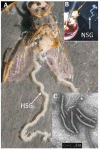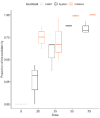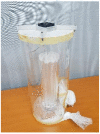The Insect Pest Control Laboratory of the Joint FAO/IAEA Programme: Ten Years (2010-2020) of Research and Development, Achievements and Challenges in Support of the Sterile Insect Technique
- PMID: 33924539
- PMCID: PMC8070182
- DOI: 10.3390/insects12040346
The Insect Pest Control Laboratory of the Joint FAO/IAEA Programme: Ten Years (2010-2020) of Research and Development, Achievements and Challenges in Support of the Sterile Insect Technique
Abstract
The Joint FAO/IAEA Centre (formerly called Division) of Nuclear Techniques in Food and Agriculture was established in 1964 and its accompanying laboratories in 1961. One of its subprograms deals with insect pest control, and has the mandate to develop and implement the sterile insect technique (SIT) for selected key insect pests, with the goal of reducing the use of insecticides, reducing animal and crop losses, protecting the environment, facilitating international trade in agricultural commodities and improving human health. Since its inception, the Insect Pest Control Laboratory (IPCL) (formerly named Entomology Unit) has been implementing research in relation to the development of the SIT package for insect pests of crops, livestock and human health. This paper provides a review of research carried out between 2010 and 2020 at the IPCL. Research on plant pests has focused on the development of genetic sexing strains, characterizing and assessing the performance of these strains (e.g., Ceratitis capitata), elucidation of the taxonomic status of several members of the Bactrocera dorsalis and Anastrepha fraterculus complexes, the use of microbiota as probiotics, genomics, supplements to improve the performance of the reared insects, and the development of the SIT package for fruit fly species such as Bactrocera oleae and Drosophila suzukii. Research on livestock pests has focused on colony maintenance and establishment, tsetse symbionts and pathogens, sex separation, morphology, sterile male quality, radiation biology, mating behavior and transportation and release systems. Research with human disease vectors has focused on the development of genetic sexing strains (Anopheles arabiensis, Aedes aegypti and Aedes albopictus), the development of a more cost-effective larvae and adult rearing system, assessing various aspects of radiation biology, characterizing symbionts and pathogens, studying mating behavior and the development of quality control procedures, and handling and release methods. During the review period, 13 coordinated research projects (CRPs) were completed and six are still being implemented. At the end of each CRP, the results were published in a special issue of a peer-reviewed journal. The review concludes with an overview of future challenges, such as the need to adhere to a phased conditional approach for the implementation of operational SIT programs, the need to make the SIT more cost effective, to respond with demand driven research to solve the problems faced by the operational SIT programs and the use of the SIT to address a multitude of exotic species that are being introduced, due to globalization, and established in areas where they could not survive before, due to climate change.
Keywords: area-wide integrated pest management; autocidal control; competitiveness; genetic sexing; genetics and molecular biology; human disease vectors; livestock bests; mass-rearing; plant pests; quality control; radiation.
Conflict of interest statement
The authors declare that there are no conflicts of interest.
Figures









Similar articles
-
Resolving cryptic species complexes of major tephritid pests.Zookeys. 2015 Nov 26;(540):5-39. doi: 10.3897/zookeys.540.9656. eCollection 2015. Zookeys. 2015. PMID: 26798252 Free PMC article.
-
Genetics and biology of Anastrepha fraterculus: research supporting the use of the sterile insect technique (SIT) to control this pest in Argentina.BMC Genet. 2014;15 Suppl 2(Suppl 2):S12. doi: 10.1186/1471-2156-15-S2-S12. Epub 2014 Dec 1. BMC Genet. 2014. PMID: 25471175 Free PMC article. Review.
-
Enterobacter sp. AA26 gut symbiont as a protein source for Mediterranean fruit fly mass-rearing and sterile insect technique applications.BMC Microbiol. 2019 Dec 24;19(Suppl 1):288. doi: 10.1186/s12866-019-1651-z. BMC Microbiol. 2019. PMID: 31870292 Free PMC article.
-
Improving Sterile Insect Technique (SIT) for tsetse flies through research on their symbionts and pathogens.J Invertebr Pathol. 2013 Mar;112 Suppl(0):S2-10. doi: 10.1016/j.jip.2012.07.009. Epub 2012 Jul 24. J Invertebr Pathol. 2013. PMID: 22841636 Free PMC article. Review.
-
Sterile Insect Technique (SIT) and Its Applications.Insects. 2021 Jul 13;12(7):638. doi: 10.3390/insects12070638. Insects. 2021. PMID: 34357298 Free PMC article.
Cited by
-
Effects of Chilling and Anoxia on the Irradiation Dose-Response in Adult Aedes Mosquitoes.Front Bioeng Biotechnol. 2022 May 2;10:856780. doi: 10.3389/fbioe.2022.856780. eCollection 2022. Front Bioeng Biotechnol. 2022. PMID: 35586555 Free PMC article.
-
Female Sex Determination Factors in Ceratitis capitata: Molecular and Structural Basis of TRA and TRA2 Recognition.Insects. 2023 Jul 4;14(7):605. doi: 10.3390/insects14070605. Insects. 2023. PMID: 37504611 Free PMC article.
-
Demographic and historical processes influencing Cochliomyia hominivorax (Diptera: Calliphoridae) population structure across South America.Parasit Vectors. 2025 Jan 20;18(1):18. doi: 10.1186/s13071-024-06622-w. Parasit Vectors. 2025. PMID: 39833956 Free PMC article.
-
Bacterial Symbionts in Ceratitis capitata.Insects. 2022 May 19;13(5):474. doi: 10.3390/insects13050474. Insects. 2022. PMID: 35621808 Free PMC article.
-
Evaluating the biological quality of mass-reared Anopheles arabiensis males irradiated as pupae or as adults.Malar J. 2025 Jul 1;24(1):212. doi: 10.1186/s12936-025-05455-x. Malar J. 2025. PMID: 40598502 Free PMC article.
References
-
- Vreysen M.J.B., Robinson A.S. Ionising radiation and area-wide management of insect pests to promote sustainable agriculture. A review. Agron. Sustain. Dev. 2011;31:233–250. doi: 10.1051/agro/2010009. - DOI
-
- FAO . The State of Food Security and Nutrition in the World. FAO; Rome, Italy: 2018.
-
- Roser M., Ritchi H. “Technological Progress” Published online at OurWorldInData.org. [(accessed on 13 April 2021)]; Available online: https://ourworldindata.org/technological-progress.
-
- Dagen M. Antimalarial Agents. Elsevier; Amsterdam, The Netherlands: 2020. History of malaria and its treatment; pp. 1–48.
-
- Sharma A., Kumar V., Shahzad B., Tanveer M., Sidhu G.P.S., Handa N., Kohli S.K., Yadav P., Bali A.S., Parihar R.D. Worldwide pesticide usage and its impacts on ecosystem. SN Appl. Sci. 2019;1:1–16. doi: 10.1007/s42452-019-1485-1. - DOI
Publication types
LinkOut - more resources
Full Text Sources
Other Literature Sources
Research Materials
Miscellaneous

